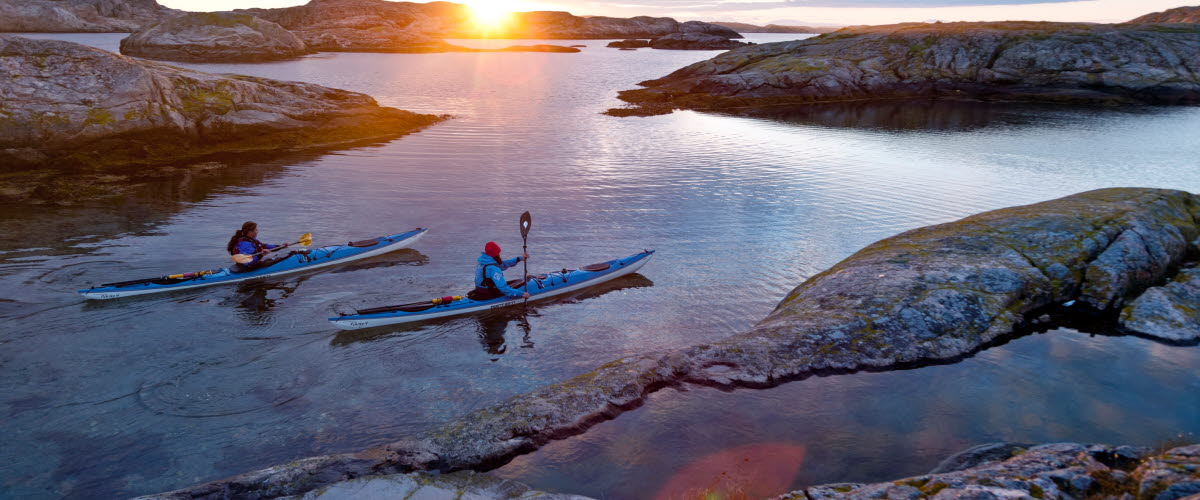Kayaking year-round in Bohuslän archipelago
Who doesn’t love kayaking the waters of Bohuslän in summertime? But what about the other seasons of the year? Paddling here in the winter and spring, outside the peak seasons, takes you closer to the real Bohuslän and lets you enjoy its true nature.
Experienced kayakers often come here in the winter and spring to enjoy the peace and tranquillity and to have the waters around the islands almost to themselves. Being at one with nature takes on a new meaning as you glide past the barren and smooth granite isles, leaving your everyday cares and concerns behind you. In these seasons you have to be more aware of the wind, waves and the weather conditions, but with the right preparations and gear, it is a blast.
Winter paddling
Winter paddling gives you unrivalled access to the Bohuslän archipelago and its wildlife. Harbour seals now venture in to the inner archipelago. Little auks, guillemots and black guillemots enjoy the open waters here before heading to the Arctic in springtime and as the big freeze covers the lakes of Dalsland, goldeneye and goosander also gather here.
Paddling conditions come wintertime can be hard and sometimes the going gets tough. But the rewards are perfect peace and tranquillity in one of the world’s most beautiful wilderness areas – and a dip in a hot-tub at the day’s end. Afterwards you can enjoy a meal of local delicacies.
Winter paddling in a crystal clear archipelago
In winter the sea air is clearer than ever, and a profound stillness settles over the rocks and bays, as if the whole coastline has taken a deep breath and is filling its lungs with fresh oxygen. It’s a perfect time to get out on an adventure and experience the archipelago from a kayak.
Here is a selection of companies in Bohuslän that offer winter paddling, including guide and drysuit:
Photographer: Roger Borgelid
Year-round paddling
Tips and advice:
January – Short days (4 hours of daylight), magical light and very cold in the water (-1 to +2 degrees). Drysuit and guide recommended. Can be a lot of ice on lakes and waterways, and drift ice, however there is still open, paddleable water out at sea.
February– Short days (5 hours of daylight), magical light and very cold water (-1 to +2 degrees). Drysuit and guide recommended. Lakes and waterways can be frozen, there is however open and paddleable water at sea.
March – Getting lighter, very cold in the water (+2 to +5 degrees). Drysuit and guide recommended. A memorable month for paddling.
April – Stable weather with warmer days and cold nights, the first pleasure boats back on the water, animal life starting to re-appear, the first plants starting to grow, still very cold in the water (+5 to + 8 degrees), drysuit and guide recommended – lovely month for paddling.
May – The ice has gone and the days are warm, while the nights are cool. Nature is in full bloom and you should navigate the waters carefully as recreational boats are out on weekends. The water is cold at +10 C to +14 C. A fantastic month for kayaking.
June – Weather conditions are stable and the wind picks up in the morning (around 6 m/s). The days and nights are warm and there are more recreational boats in the archipelago at weekends. The water is cool at +15 C to +18 C. A great month for kayaking.
July – The weather becomes unstable and there is a strong sea breeze in west-north direction, usually between 10.00 and 14.00 with winds of up to 12 m/s. There are many recreational boats in the archipelago. The water temperature is between +18 C and +21 C.
August – The weather is more stable, but with a sea breeze. There are fewer recreational boats in the archipelago towards the end of the month and the water temperature is +21 C. A fantastic month for paddling.
September – The weather is stable and there are very few recreational boats around. The days are cooler, as are the nights. The blazing colours of autumn come to the archipelago and the water cools to +15 C to +17 C. Drysuit and guide recommended - a fantastic month for paddling.
October – The weather becomes unstable, characterised by low pressure weather systems and strong winds. The lobster fishing season is in full swing and there are many recreational boats around. The days get shorter with just 6 hours’ of daylight and the water is colder at +10 C to +14 C. Drysuit and guide recommended.
November – Usually more stable weather, with possibly some snow beginning to turn the archipelago white. Hardly any boats, short days (5 hours daylight), animals in the archipelago starting to change their coats for winter, water cold (+ 8 to + 12 degrees). Drysuit and guide recommended – an adventurous month for paddling.
December – Lovely, white winter days interspersed with snow storms, this month includes the shortest day of the year (4 hours of daylight). Beautiful light, quiet time for animal life, silence, very cold in the water (+ 3 to + 6 degrees). Drysuit and guide recommended – fine month for paddling.
Winter paddling in Sweden's largest lake, Vänern
Winter paddling in Vänern is a fantastic experience. The water is still and quiet, so you really feel like you’re living in the moment. Naven Outdoor offers guided tours all year round in both the Vänern archipelago and around Läckö Castle. Maybe you’d like to try an atmospheric full moon paddle, or dark night paddling?
MORE ABOUT PADDLING IN WEST SWEDEN


